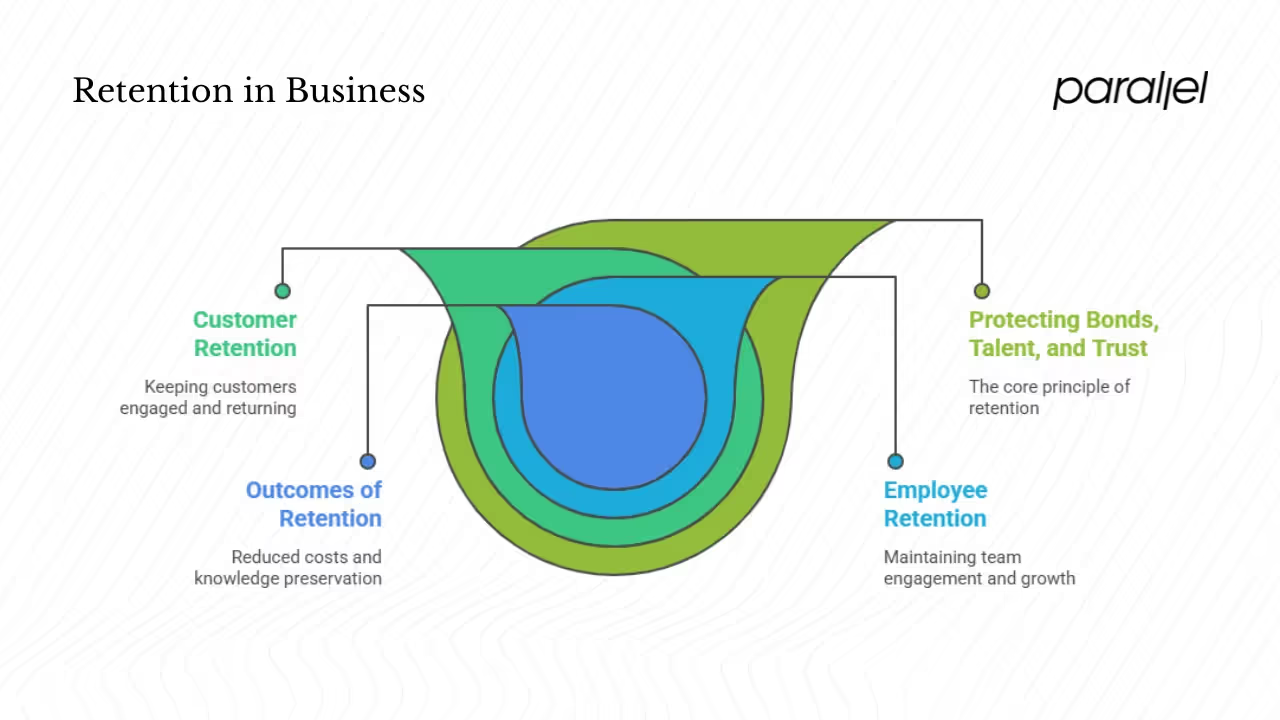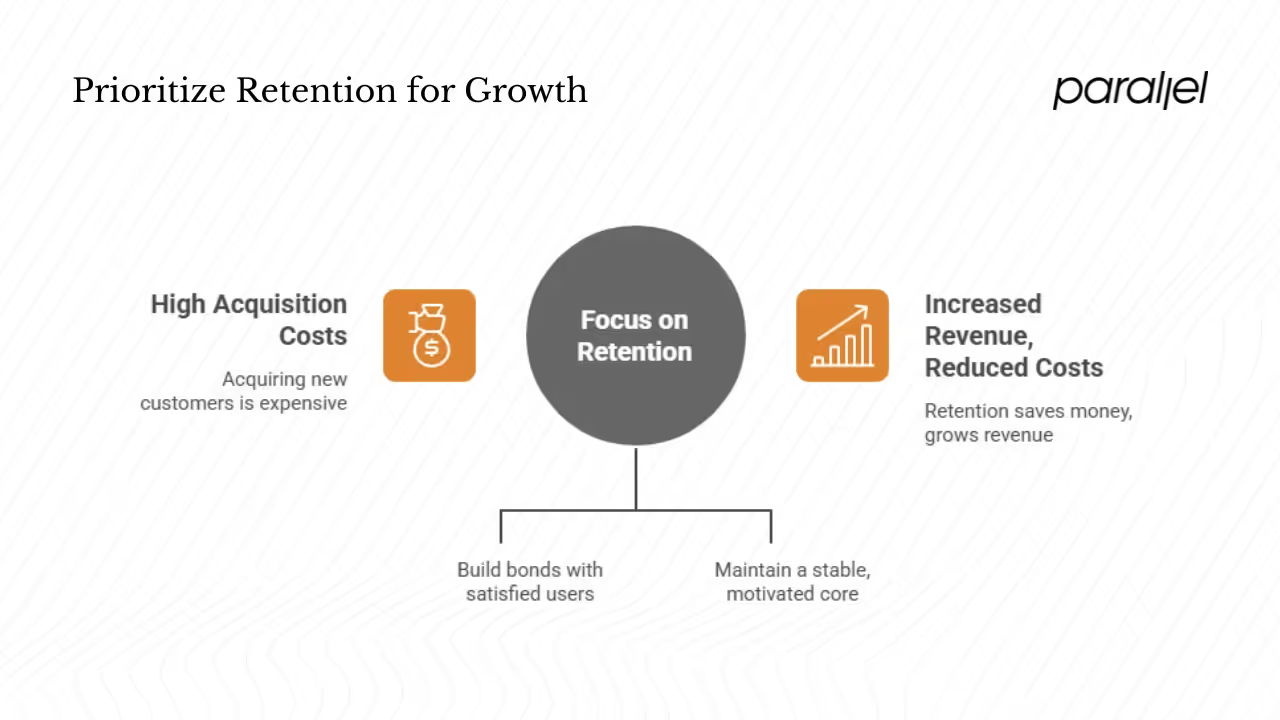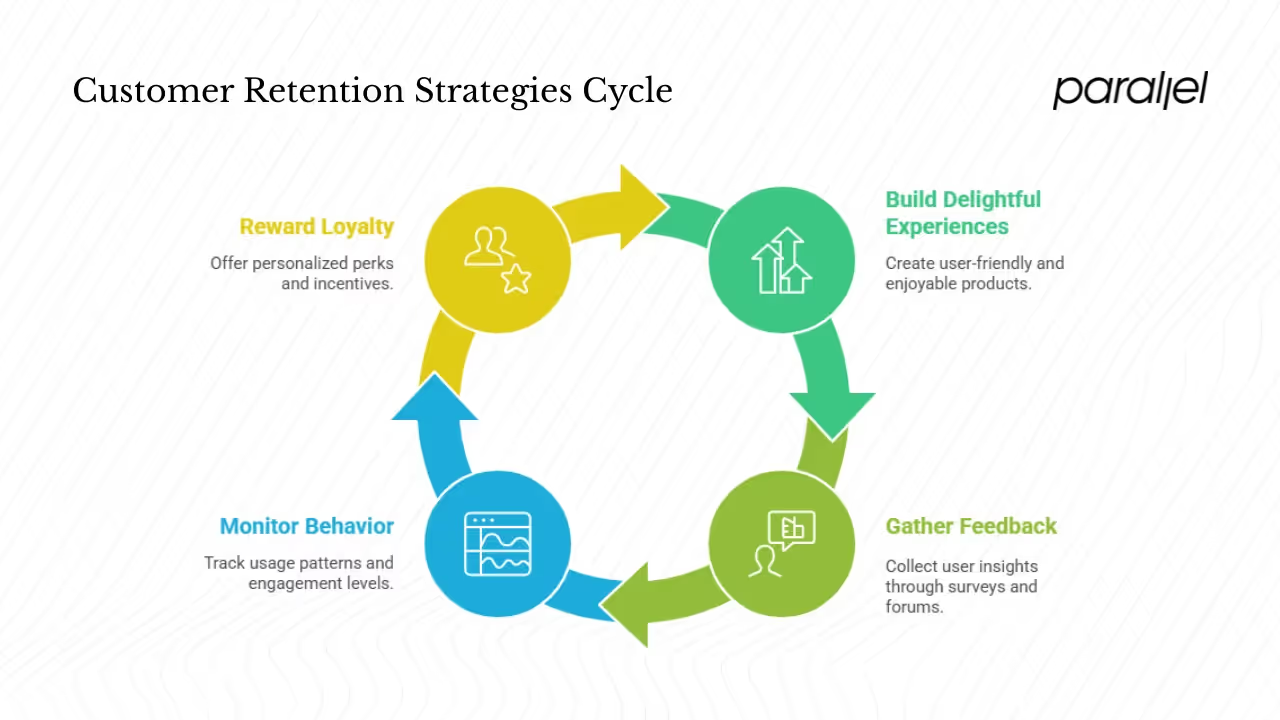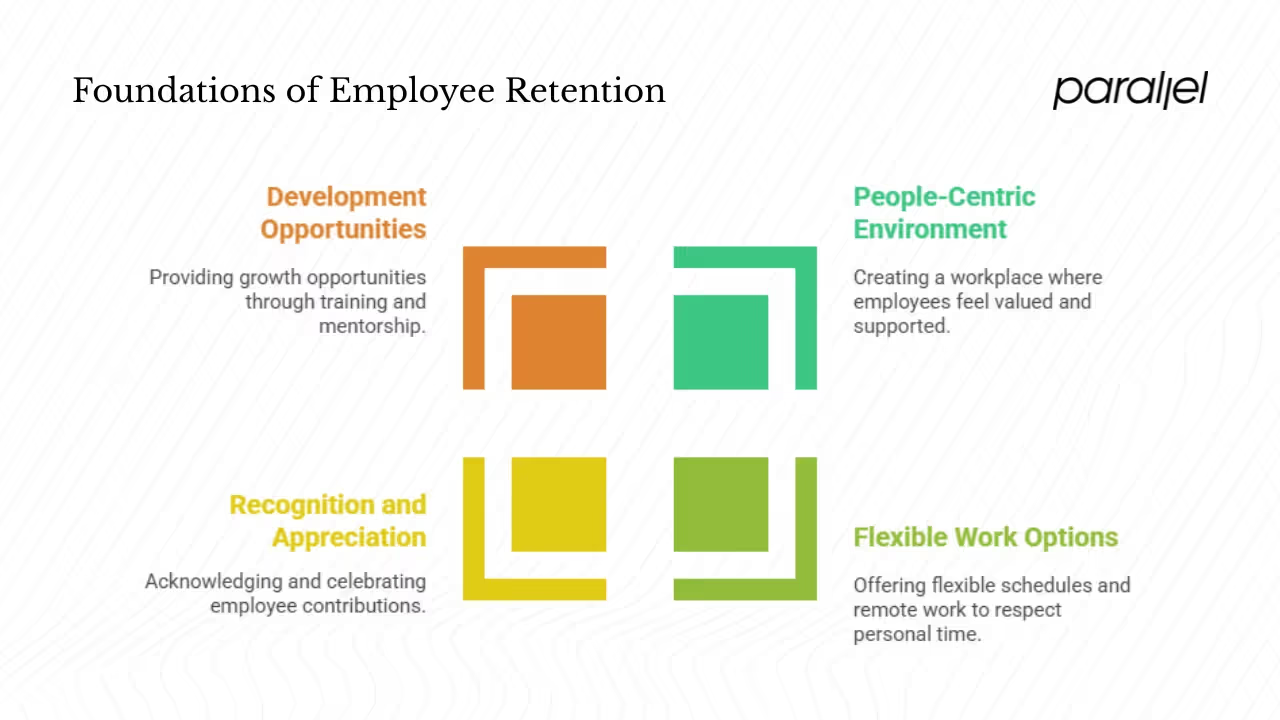What Is Retention in Business? Guide (2025)
Understand the concept of retention in business, why it matters, and techniques to keep customers engaged and loyal.

As product and design leaders building ML/SaaS startups at Parallel, we often field a simple question: what is retention in business? This phrase means holding on to the customers and employees you already have. In a world where marketing budgets swell and talent markets churn, keeping the people who already believe in your product is often the difference between a healthy company and a sinking one. For early‑stage teams, paying attention to retention keeps costs down, boosts loyalty, and informs product direction.
In this guide I’ll unpack the metrics and strategies that matter for both customer and employee retention, drawing on research and years of hands‑on work with growing startups. By the end you’ll know what the crucial numbers mean, how to improve them, and why retention isn’t just a support function but a core product challenge.
What is retention in business?
Before we get into metrics, it’s important to answer the basic question: what is retention in business? From the customer side, retention refers to how well a product or service keeps people coming back. A high retention rate means customers continue to pay, renew subscriptions, or make repeat purchases over time.
From the employee side, retention is about maintaining the team you have and reducing turnover. It reflects the ability to keep good people engaged and growing instead of watching them leave for other opportunities. Both types share a common principle: protecting bonds, talent and trust. When retention drops, you spend more on new marketing or recruiting while losing accumulated knowledge and advocacy.

Retention, whether of users or colleagues, is not just a number. It reflects the human side of a business: how effectively you meet needs, how connected people feel to your product or mission, and how supported your team members feel in their roles. This perspective shapes the rest of the guide and helps answer what is retention in business in practical terms.
Why retention matters

Customers: investment versus reward
Acquiring new customers is expensive. Research aggregated by Rivo and other firms shows that retaining customers costs roughly five times less than acquiring new ones. A modest 5 percent increase in customer retention can boost profits between 25 percent and 95 percent. A 2025 snapshot on Sprinklr reports that 50 percent of existing customers are more prone to try a new product and 31 percent spend more than new customers. These numbers show why focusing on current users saves money and grows revenue.
Emotional attachment makes users 52 percent more valuable. Thoughtful onboarding and loyalty programs build bonds that turn satisfied users into advocates.
Employees: hidden costs of turnover
Employee retention often gets less attention until it’s too late. Yet turnover is incredibly costly. Search results from 2025 HR analyses show that turnover can cost between 33 percent and 200 percent of an employee’s salary; one report says replacing a single worker can cost around 33 percent of their annual salary. These expenses come from recruiting fees, onboarding time, lost productivity, and the impact on morale. When experienced people leave, their knowledge of product history, customer preferences and process quirks goes with them. Remaining team members often absorb extra duties, leading to burnout.
For a startup working on a tight runway, these costs can derail product schedules and distract leaders from customer value. That’s why retention is as critical for your internal team as it is for your user base. When you maintain a stable core of motivated employees, you preserve institutional memory and free up energy for innovation.
Important metrics and terms
To improve retention, you need clear metrics. Here are the terms that matter when discussing what is retention in business metrics:
- Churn rate – the percentage of customers who leave over a given period. A high churn rate signals dissatisfaction or poor product fit.
- Retention rate – the percentage of customers who stay. It can be computed as (ending customers – new customers) ÷ starting customers. Tracking retention rate over time shows whether improvements are working.
- Lifetime value (CLV) – the total revenue a customer generates over their bond with your product. Strong retention boosts CLV significantly.
- Customer satisfaction and engagement – survey scores, usage frequency and other measures indicate how happy users are. Higher satisfaction correlates with lower churn.
- Repeat business and renewal – repeat purchases, subscription renewals and upsells. These numbers show how retention translates to revenue.
- Employee retention – often measured as the percentage of staff who stay over a set period. It ties into job satisfaction, the work environment and growth opportunities.
These metrics are not static; they require interpretation. A single month’s churn might spike due to a bug or pricing change. The important part is to track trends and pair the numbers with qualitative feedback. Knowing what is retention in business metrics helps you interpret them correctly.
Strategies for customer retention
After answering what is retention in business, the next question is how to improve it. Over the years of partnering with early‑stage ML/SaaS companies, we’ve developed a playbook based on both research and lived experience.

Build delightful experiences and feedback loops
People stay when they enjoy using your product and feel heard. That starts with a product experience that solves real problems without friction. Testing with just five users can reveal most usability issues. We run rapid usability sessions and build continuous feedback mechanisms—like in‑app surveys and forums—so we can spot trends before they become issues.
Monitor behaviour and reward loyalty
Data is your ally. Track usage patterns and engagement frequency. Look for early signs of churn, such as decreased login activity. Automated messages can guide users back to value. Rewards also make customers feel appreciated. Instead of generic discounts, offer perks based on usage patterns or milestones, such as early access to new features. Research indicates that existing customers spend significantly more and are more open to new offerings.
Strategies for employee retention
Retention is also about your team. Here are approaches we’ve seen work.

Build a people‑centric environment
The most effective leaders create conditions where people can do their best work. That means clear expectations, constructive feedback and growth opportunities. Regularly check in with team members about what’s working and what isn’t, and encourage autonomy rather than micro‑managing. Provide clarity on professional growth so people see a path forward.
Flexible schedules and remote work options have become common since 2020, but early‑stage teams sometimes ignore them in the rush to ship. Respecting personal time and offering flexibility builds goodwill that translates to loyalty. Recognition matters too. Small, frequent acknowledgments of good work often mean more than a yearly bonus. Listening to your colleagues and adjusting course when issues surface is part of the same commitment to retention.
Support development and recognise contributions
Employees stay when they feel they are growing. Set up personal development plans that match individual goals with business goals. Invest in training, mentorship and cross‑functional projects so people can expand their skills. When someone expands your product’s capabilities or resolves a tough bug, celebrate it publicly. Sharing the spotlight encourages a sense of ownership.
Retention in practice: product and design leadership
Why should product and design leaders care so deeply about retention? Because it informs every strategic decision. When you understand what is retention in business, you realise that new features or redesigns only succeed when they improve the long‑term experience. Here’s how retention shows up in daily work.
Using behavioural insights to prioritise features
Metrics like churn and feature adoption show where users struggle or thrive. When deciding what to build next, look at segments with declining engagement. For example, if churn spikes when users hit a usage limit, it might be better to improve pricing clarity before adding new features. Data‑driven prioritisation keeps your product aligned with real needs.
Behavioural metrics are useful, but they don’t tell the whole story. Pair numbers with qualitative research—interviews, observation, and support tickets—to understand why people stay or leave. Sometimes churn is driven by hidden friction, like confusing terminology or poorly timed emails. Other times it reflects mismatched expectations about pricing or support. Early‑stage teams benefit from talking directly with users and synthesising those stories with data to find patterns.
Blurring the lines between product and HR
Retention isn’t just the responsibility of a customer success team or human resources. Product decisions influence retention, and workplace policies affect user experience. A developer who is burnt out might rush a release, introducing bugs that frustrate users. Likewise, a product that fails to meet expectations can demoralise the support team. Leaders who recognise this interdependence are better equipped to build sustainable businesses. The Nielsen Norman Group reminds us that prioritising user loyalty over short‑term gains leads to sustainable growth by building trust and long‑term profitability.
Conclusion: choose retention for sustainable growth
As founders and product leaders, we often obsess over acquisition: how to attract more users, raise another round or hire rapidly. Yet what is retention in business if not the engine that keeps those gains from slipping away? Investing in retention—of both customers and employees—keeps costs in check and enables steady growth. Existing customers are more prone to buy, spend more and promote your product. Small improvements in retention can drive large profit increases, and emotionally connected users are far more valuable. For employees, reducing turnover saves money and preserves knowledge.
Teams that succeed long‑term build for loyalty from day one. They view user feedback as gold, support their people, and see retention as a product challenge rather than an afterthought. My invitation to you is to run similar experiments: track retention metrics alongside acquisition, invest in research and listening, and be intentional about how your work environment shapes engagement. Growth comes not just from adding more, but from caring for the people already in your orbit.
Retention is cross‑disciplinary. Designers, product managers, support teams and leadership all influence whether people stay. For example, a clear onboarding flow designed by the product team reduces support tickets, while a transparent pricing page created with marketing prevents surprises. The work environment affects product quality too; a happy engineer is more prone to write thoughtful code and fix issues before they affect users. By treating retention as a shared responsibility rather than a siloed metric, startups can build resilience into their products and teams. When retention improves, you gain time and resources to innovate, experiment and serve your community.
FAQ
1) What is the meaning of retention in business?
Retention means keeping customers or employees over time. In a customer context it refers to encouraging people to continue using your product or service. In an employee context it refers to how well a company keeps its staff. Both forms of retention prevent costly churn.
2) What does retention mean in a job?
It refers to an organisation’s ability to maintain its workforce. High retention means fewer departures and more long‑term engagement. Losing staff can cost 33 percent or more of an employee’s salary.
3) What does retention mean in simple terms?
It’s about not losing what you have. In business, retention is the practice of keeping customers and employees instead of constantly chasing new ones. Stable bonds save money and build loyalty.
4) Why is retention important to a business?
Because replacing customers or employees is costly and disruptive. Retention leads to more value, less waste and a sturdier path to growth. Existing customers are more prone to buy and spend more, while keeping employees preserves institutional knowledge and saves on hiring costs.









.avif)



